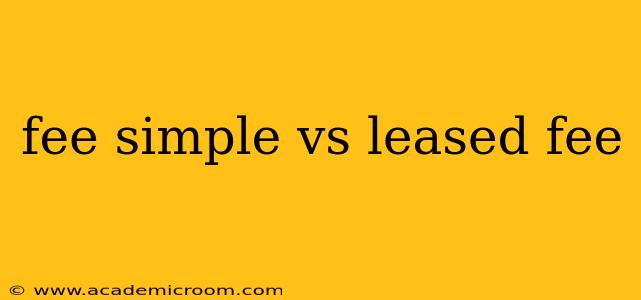Understanding the nuances of real estate ownership can be complex, especially when differentiating between fee simple and leased fee interests. Both involve ownership, but the nature and extent of that ownership differ significantly, impacting rights, responsibilities, and investment strategies. This comprehensive guide will clarify the core distinctions between fee simple and leased fee interests, answering common questions and providing valuable insights for investors and property owners alike.
What is Fee Simple Ownership?
Fee simple, often referred to as "fee simple absolute," represents the most complete form of ownership in real estate. It grants the owner—the fee simple owner—the fullest bundle of rights possible. This includes the right to possess, use, enjoy, and dispose of the property as they see fit, subject only to government regulations (like zoning laws) and private restrictions (like homeowner association rules). Essentially, the fee simple owner has virtually unrestricted control over the property. They can sell, lease, mortgage, or even destroy the property (though the latter is usually unwise!). This ownership is inheritable, passing to heirs upon the owner's death unless otherwise specified in a will.
What is Leased Fee Ownership?
Leased fee ownership, in contrast, represents the ownership interest retained by a landlord after granting a lease to a tenant. The leased fee owner still holds title to the property, but their rights are limited by the terms of the lease agreement. They receive lease payments from the tenant in exchange for granting them exclusive use of the property for a specific period. During the lease term, the leased fee owner's control over the property is restricted. They cannot occupy or use the property unless specifically permitted by the lease. Their ability to sell the property is also limited; the sale would be subject to the existing lease, and the new owner would inherit the responsibilities and benefits of the leased fee interest.
What are the Key Differences Between Fee Simple and Leased Fee?
The core difference lies in the degree of control and the type of income generated.
| Feature | Fee Simple | Leased Fee |
|---|---|---|
| Ownership | Complete and unrestricted ownership | Ownership subject to lease terms |
| Control | Full control over property use and disposal | Limited control during lease term |
| Income | Potential income from property appreciation or rent (if leased) | Primarily income from lease payments |
| Risk | Full responsibility for property expenses | Some responsibility, depending on lease terms |
| Transferability | Freely transferable | Transferable, subject to existing lease |
What are the Advantages and Disadvantages of Each?
Fee Simple Advantages:
- Complete Control: Unrestricted use and disposal of the property.
- Potential for Appreciation: The owner benefits fully from any increase in property value.
- Long-Term Ownership: Ownership passes to heirs upon death unless otherwise specified.
Fee Simple Disadvantages:
- Full Responsibility: The owner bears all property expenses and risks.
- Higher Initial Investment: Requires a larger upfront investment to purchase the property outright.
Leased Fee Advantages:
- Passive Income: Steady stream of income from lease payments.
- Lower Initial Investment: Lower upfront cost compared to buying a fee simple interest.
- Diversification: Potentially less volatile investment than fee simple ownership.
Leased Fee Disadvantages:
- Limited Control: The owner's control over the property is restricted during the lease term.
- Rent Risk: Potential loss of income if the tenant defaults on lease payments.
- Depreciation: Leased Fee owner is responsible for maintaining the property for lease compliance.
How do Lease Terms Affect Leased Fee Value?
The terms of the lease significantly influence the value of the leased fee interest. A long-term lease with favorable terms (e.g., a triple net lease where the tenant pays for most expenses) can significantly increase the value of the leased fee. Conversely, a short-term lease with unfavorable terms (e.g., the landlord bearing significant expenses) can reduce its value. The remaining lease term and the rent levels are crucial factors in determining the worth of a leased fee investment.
What are some examples of Leased Fee Investments?
Common examples include:
- Ground Leases: Owning the land and leasing it to a developer to build on.
- Net Lease Properties: Commercial properties where the tenant is responsible for most or all operating expenses.
- Triple Net Lease Properties: Commercial properties where the tenant pays for property taxes, insurance, and maintenance.
What taxes are associated with each?
Both Fee Simple and Leased Fee interests are subject to property taxes. The responsibility for paying property taxes often falls on the fee simple owner, though this can be modified by the terms of a lease. For leased fee owners, taxes will still be a consideration that impact their overall return.
Understanding the differences between fee simple and leased fee ownership is crucial for anyone involved in real estate. This knowledge allows investors to make informed decisions, balancing risk and reward according to their investment objectives and risk tolerance. Remember to seek professional advice from real estate experts and legal counsel when making significant real estate investment decisions.
